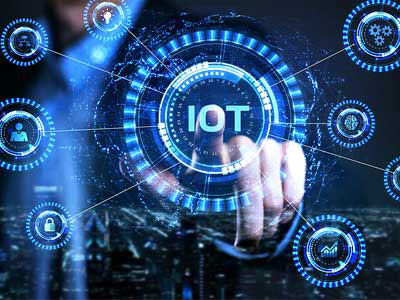Key Takeaway
IoT is used across many industries to improve efficiency and innovation. In smart cities, IoT enhances traffic management and energy use. Smart homes use IoT for automation and security. Supply chain management benefits from real-time tracking and inventory control. Agriculture employs IoT for precision farming, improving crop yields. Enterprise solutions leverage IoT for data analytics and process automation. Wearables monitor health and fitness. Connected factories with Industrial IoT improve manufacturing processes and predictive maintenance. Finally, retail uses IoT for inventory management and personalized customer experiences. These applications highlight the versatility and impact of IoT across various sectors.
Manufacturing and Production
In manufacturing and production, IoT is pivotal. It enables predictive maintenance, which reduces downtime and enhances equipment efficiency. Sensors monitor machinery health, predicting failures before they occur. This proactive approach saves time and money.
Moreover, IoT facilitates smart manufacturing. Machines communicate with each other, optimizing production processes. Real-time data analytics help in decision-making, improving product quality and reducing waste. Inventory management is also streamlined, ensuring materials are available when needed without overstocking.
For example, in a car manufacturing plant, IoT can track the production line in real-time, adjusting workflows to prevent bottlenecks. This leads to smoother operations and higher productivity. Ultimately, IoT in manufacturing drives innovation and operational excellence.

Energy and Utilities
The energy and utilities sector benefits immensely from IoT. Smart grids are a prime example, offering efficient energy distribution and real-time monitoring. IoT devices track energy consumption patterns, helping in demand forecasting and reducing energy wastage. Imagine a smart grid system that detects a surge in energy use during peak hours and automatically adjusts the supply, ensuring a balanced load. This not only optimizes energy use but also enhances the reliability of power distribution networks.
In renewable energy, IoT plays a crucial role. Wind turbines and solar panels equipped with sensors provide data on performance and environmental conditions. This information helps in optimizing energy production and maintenance schedules. For example, sensors on solar panels can detect dust accumulation, triggering automatic cleaning systems or maintenance alerts. Utility companies use IoT for smart meters, providing accurate readings and eliminating manual meter reading. This enhances billing accuracy and customer satisfaction. Smart water meters, for instance, detect leaks early, preventing water wastage and saving costs. IoT in energy and utilities is about creating a sustainable and efficient future, integrating advanced technology to make energy management smarter and more responsive.
Healthcare and Medical
IoT is transforming healthcare by improving patient care and operational efficiency. Wearable devices monitor vital signs, allowing for remote patient monitoring. This continuous data stream helps in early diagnosis and timely interventions. For instance, a wearable heart monitor can alert a patient and their doctor about irregular heartbeats, enabling swift medical responses. In hospitals, IoT enhances asset management. Medical equipment tracked in real-time ensures availability when needed, reducing search times and improving patient care.
Telemedicine has gained traction, especially during the pandemic. IoT enables virtual consultations, bridging the gap between patients and healthcare providers. Imagine a scenario where a heart patient is monitored remotely, with data sent to the doctor in real-time, ensuring prompt care. IoT also aids in medication management, ensuring patients receive the correct dosage at the right time. For example, smart pill bottles remind patients to take their medication and notify caregivers if doses are missed. IoT in healthcare is about making medical services more accessible and efficient, leveraging technology to provide better care and improve patient outcomes.
Agriculture and Farming
IoT is revolutionizing agriculture by making it more efficient and sustainable. Precision farming uses IoT devices to monitor soil conditions, weather patterns, and crop health. This data helps farmers make informed decisions, optimizing resource use and increasing yield. Automated irrigation systems, controlled by IoT sensors, ensure crops receive the right amount of water, reducing wastage. For instance, when soil moisture levels drop, the system activates, conserving water and enhancing crop growth.
Livestock farming also benefits significantly from IoT. Sensors monitor animal health, tracking vital signs and movement. This information helps in early disease detection and improving overall animal welfare. For example, a dairy farm can monitor cow health and milk production, ensuring optimal conditions for maximum yield. Drones equipped with IoT devices monitor large fields, providing valuable data on crop health and pest infestations. IoT in agriculture is about enhancing productivity while being environmentally friendly, ensuring that farming practices are sustainable and effective
Transportation and Logistics
In transportation and logistics, IoT ensures efficiency and safety. Fleet management systems track vehicles in real-time, optimizing routes and reducing fuel consumption. This leads to timely deliveries and cost savings. Sensors monitor goods throughout the journey, ensuring proper handling and reducing losses. For example, temperature-sensitive products like pharmaceuticals can be monitored to ensure they remain within the required temperature range during transit.
IoT also enhances supply chain visibility. In urban transportation, smart traffic lights and sensors monitor traffic flow, reducing congestion and improving travel times. Public transport systems benefit from IoT by providing real-time updates to commuters, enhancing their experience. Imagine a scenario where a commuter gets instant updates about bus timings and delays, making their travel more convenient. IoT in transportation and logistics is about making systems smarter and more efficient, ensuring seamless operations and improved customer satisfaction.
Conclusion
The adoption of IoT across various industries is driven by its ability to enhance efficiency, reduce costs, and improve service quality. From manufacturing and energy to healthcare, agriculture, and transportation, IoT is transforming operations and driving innovation.
As IoT technology advances, its applications will continue to expand, offering even more benefits. For businesses, embracing IoT is no longer optional but essential for staying competitive. The future of industries is interconnected, smart, and efficient, thanks to the power of IoT.
